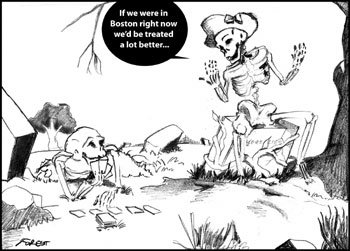Help preserve a community treasure
Illustration by Forest Byrd
If a gravestone falls in the New Scotland Cemetery, who will set it aright"
The three women who are most involved in the cemetery association Corinne Weeks, Martha Oden, and Arlene Herzog arent so young anymore.
They physically arent up to the task. And they shouldnt have to bear the burden alone.
An old, rural cemetery like the one in New Scotland embodies a history that is important to an entire community.
The cemetery lies behind the Presbyterian church in New Scotland; organized in 1787, its the oldest church in town.
Revolutionary War soldiers are buried there, in the only part of the cemetery still connected to the church. One of them belongs to Jacob Moak, a member of the Albany County Militia, who died in 1795.
We printed pictures of the graveyard last week, taken by reporter Rachel Dutil, that broke our heart. A clump of trees had grown around one stone, wrenching it from its rightful place and turning it askew. The name on the stone, obscured by the bark, could not be read. Another stone had fallen to the ground and was mostly covered with brush and leaves.
We commend the efforts of local Boy Scouts who, under the leadership of Bill Morrison, have worked to straighten and clean the stones of the Revolutionary War soldiers. Their stones now stand proud in rows befitting a regiment.
But why should the good deeds be left just to the boys"
A concerted effort from others in the community would be more than welcome. New Scotland could borrow an idea from Berne in the Helderbergs that overlook the cemetery. In recent years, part of the Berne Heritage Day celebration has been devoted to volunteer work to reclaim old cemeteries. The Heritage Day organizers are wise to recognize the value of their towns cemeteries.
We can envision adding the New Scotland Cemetery to the list of chores to be performed by volunteers during the towns annual spring clean-up day. Some of those one-day volunteers might become interested in graveyard preservation as some in Berne have.
Not only are the graves in New Scotland neglected, but the history is, too. Records to the New Scotland Cemetery prior to 1917 have been lost. Weeks, Oden, and Herzog have been working to catalog the names and dates of those buried in the cemetery but, says Herzog, "We’re missing half the people, yet."
Perhaps volunteers from one of the towns two historical societies could take this on as a worthwhile task. Much of the history of New Scotland is, quite literally, buried in the cemetery. Documenting it would benefit everyone from schoolchildren learning the history of the place where they live to local homeowners, researching the history of their historic dwellings.
The cemetery is in difficult financial straits as well. "We can afford to exist for three more years," said Herzog. The cemetery averages two to five burials a year; it charges $400 for a lot space. Burial cost is $690; the gravedigger is paid $550. In lawn care alone, the association pays about $5,000 a year.
The trio of women are searching for descendants of people buried in the cemetery to get involved in the association and help with maintenance. They also hope volunteers from the community could help for even one day a year.
"You really should have at least 20 people who want to be involved," said Herzog. "And people who are under 50." She urges anyone who wants to volunteer or anyone who has information about people buried in the cemetery to call her at 439-1559.
Mourning customs have changed over the years. There was a time when cemeteries were social centers in their communities. Not only did mourners regularly go to visit the graves of the dead but the community gathered there for events and outings, particularly on occasions like Memorial Day and Veterans Day.
Guilderland Town Historian Alice Begley revived this tradition in recent years, holding an event for Guilderlands bicentennial in Prospect Hill Cemetery at the same site where a similar gathering had been held a century before.
In a city like Boston, rich with history, cemeteries have been preserved even in the midst of rising real-estate prices. Boston graveyards serve not only as lovely park-like green spaces in the heart of a busy city but they also serve as an attraction for visitors from across the country and around the world. Those graveyards embody the history of not only a city but part of a nation.
So, too, should we honor and preserve our own history here in New Scotland. We urge New Scotlanders to view their cemetery as a resource. Schoolchildren could take field trips there to learn about their towns history. Its a lovely place for any of us to visit perched on a hillside with the Helderberg escarpment providing a serene backdrop.
America is a mobile society now. Many of us may not live near the cemetery where our ancestors were buried. But we could still care for those in our midst, in the place where we live here and now.
Death is a part of life. Each of us knows that we and everyone we love will someday die. We should care for the graves of those who died before us so that others.
Melissa Hale-Spencer, editor


